LTE UE (User Equipment) Category & Class Definitions
LTE utilises the LTE UE Category or User Equipment categories or classes to define the performance specifications of LTE devices and enables LTE base stations to be able to communicate effectively with them knowing their performance levels. Some LTE UE Categories such as LTE Cat 3, LTE Cat 4 and LTE Cat 0 are widely quoted and used. Other like LTE Cat 7 and LTE Cat 8 are much newer.
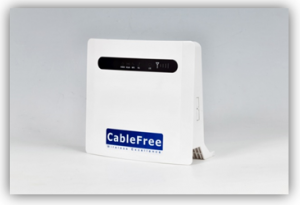
In the same way that a variety of other systems adopted different categories for the handsets or user equipments, so too there are 3G LTE UE categories. These LTE categories define the standards to which a particular handset, dongle or other equipment will operate.
CableFree LTE CPEs support the latest UE categories for high performance and capacity
LTE UE category rationale
The LTE categories or UE classes are needed to ensure that the base station, or eNodeB, eNB can communicate correctly with the user equipment. By relaying the LTE UE category information to the base station, it is able to determine the performance of the UE and communicate with it accordingly.
As the LTE category defines the overall performance and the capabilities of the UE, it is possible for the eNB to communicate using capabilities that it knows the UE possesses. Accordingly the eNB will not communicate beyond the performance of the UE.
LTE UE category definitions
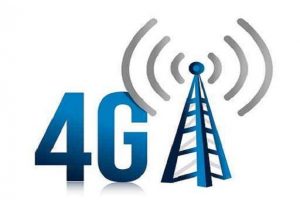
There are 20 different LTE UE categories that are defined. As can be seen in the table below, the different LTE categories have a wide range in the supported parameters and performance. LTE category 1, for example does not support MIMO, but LTE UE category five supports 4×4 MIMO.
It is also worth noting that UE class 1 does not offer the performance offered by that of the highest performance HSPA category. Additionally all LTE UE categories are capable of receiving transmissions from up to four antenna ports.
3GPP Release 8 defines five LTE user equipment categories depending on maximum peak data rate and MIMO capabilities support. With 3GPP Release 10, which is referred to as LTE Advanced, three new categories have been introduced, and four more with 3GPP Release 11.
| User equipment Category |
Max. L1 datarate Downlink (Mbit/s) |
Max. number of DL MIMO layers |
Max. L1 datarate Uplink (Mbit/s) |
3GPP Release |
|---|---|---|---|---|
| NB1 | 0.68 | 1 | 1.0 | Rel 13 |
| M1 | 1.0 | 1 | 1.0 | |
| 0 | 1.0 | 1 | 1.0 | Rel 12 |
| 1 | 10.3 | 1 | 5.2 | Rel 8 |
| 2 | 51.0 | 2 | 25.5 | |
| 3 | 102.0 | 2 | 51.0 | |
| 4 | 150.8 | 2 | 51.0 | |
| 5 | 299.6 | 4 | 75.4 | |
| 6 | 301.5 | 2 or 4 | 51.0 | Rel 10 |
| 7 | 301.5 | 2 or 4 | 102.0 | |
| 8 | 2,998.6 | 8 | 1,497.8 | |
| 9 | 452.2 | 2 or 4 | 51.0 | Rel 11 |
| 10 | 452.2 | 2 or 4 | 102.0 | |
| 11 | 603.0 | 2 or 4 | 51.0 | |
| 12 | 603.0 | 2 or 4 | 102.0 | |
| 13 | 391.7 | 2 or 4 | 150.8 | Rel 12 |
| 14 | 3,917 | 8 | 9,585 | |
| 15 | 750 | 2 or 4 | 226 | |
| 16 | 979 | 2 or 4 | n/a | |
| 17 | 25,065 | 8 | n/a | Rel 13 |
| 18 | 1174 | 2 or 4 or 8 | n/a | |
| 19 | 1566 | 2 or 4 or 8 | n/a |
Note: Maximum datarates shown are for 20 MHz of channel bandwidth. Categories 6 and above include datarates from combining multiple 20 MHz channels using Carrier Aggregation. Maximum datarates will be lower if less bandwidth is utilized.
Note: These are L1 transport data rates not including the different protocol layers overhead. Depending on cell BW, cell load, network configuration, the performance of the UE used, propagation conditions, etc. practical data rates will vary.
Note: The 3.0 Gbit/s / 1.5 Gbit/s data rate specified as Category 8 is near the peak aggregate data rate for a base station sector. A more realistic maximum data rate for a single user is 1.2 Gbit/s (downlink) and 600 Mbit/s (uplink). One vendor has demonstrated downlink speeds of 1.4 Gbit/s using 100 MHz of aggregated spectrum.
More on LTE UE Categories
A summary of the different LTE UE category parameters is given in the tables below.
Includes new LTE UE Categories: 11, 12, 13 and 14 in 3GPP Rel-12
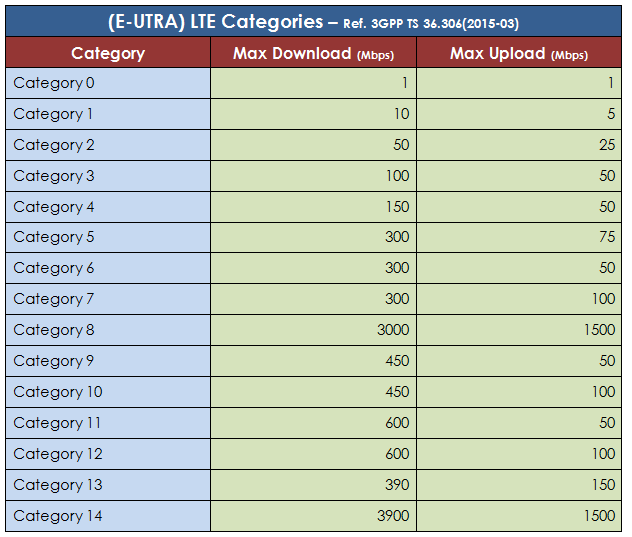
| HEADLINE DATA RATES FOR LTE CATEGORIES | ||||||||
|---|---|---|---|---|---|---|---|---|
| LTE UE CATEGORY | ||||||||
| LINK | 1 | 2 | 3 | 4 | 5 | 6 | 7 | 8 |
| Downlink | 10 | 50 | 100 | 150 | 300 | 300 | 300 | 1200 |
| Uplink | 5 | 25 | 50 | 50 | 75 | 50 | 150 | 600 |
It can be seen that the headline data rates for category 8 exceed the requiremetns for IMT-Advanced by a considerable margin.
While the headline rates for the different LTE UE categories or UE classes show the maximum data rates achievable, it is worth looking in further detail at the underlying performance characteristics.
| UL AND DL PARAMETERS FOR LTE UE CATEGORIES 1 – 5 | |||||
|---|---|---|---|---|---|
| LTE CATEGORY | |||||
| PARAMETER | LTE CAT 1 | LTE CAT 2 | LTE CAT 3 | LTE CAT 4 | LTE CAT 5 |
| Max number of DL-SCH transport block bits received in a TTI | 10 296 | 51 024 | 102 048 | 150 752 | 302 752 |
| Max number of bits of a DL-SCH block received in a TTI | 10 296 | 51 024 | 75 376 | 75 376 | 151 376 |
| Total number of soft channel bits | 250 368 | 1 237 248 | 1 237 248 | 1 827 072 | 3 667 200 |
| Maximum number of supported layers for spatial multiplexing in DL | 1 | 2 | 2 | 2 | 4 |
| Max number of bits of an UL-SCH transport block received in a TTI | 5 160 | 25 456 | 51 024 | 51 024 | 75 376 |
| Support for 64-QAM in UL | No | No | No | No | Yes |
| UL AND DL PARAMETERS FOR LTE UE CATEGORIES 6, 7, 8 | |||||
|---|---|---|---|---|---|
| LTE CATEGORY | |||||
| PARAMETER | LTE CAT 6 | LTE CAT 7 | LTE CAT 8 | ||
| Max number of DL-SCH transport block bits received in a TTI | 299 552 | 299 552 | 1 200 000 | ||
| Max number of bits of a DL-SCH block received in a TTI | TBD | TBD | TBD | ||
| Total number of soft channel bits | 3 667 200 | TBD | TBD | ||
| Maximum number of supported layers for spatial multiplexing in DL | |||||
| Max number of bits of an UL-SCH transport block received in a TTI | TBD | TBD | TBD | ||
| Support for 64-QAM in UL | No | Yes, up to RAN 4 | Yes | ||
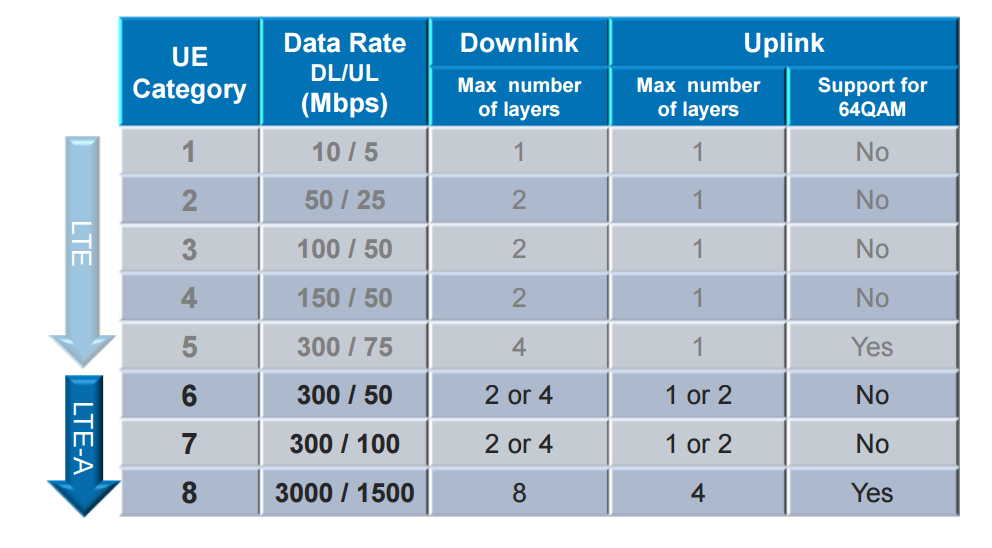
More details on LTE categories Including the new Category 9-14 modes:
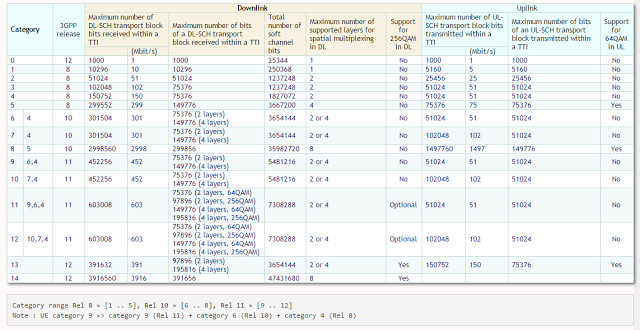
From this it can be seen that the peak downlink data rate for a Category 5 UE using 4×4 MIMO is approximately 300 Mbps, and 150 Mbps for a Category 4 UE using 2×2 MIMO. Also in the Uplink, LTE UE category 5 provides a peak data rate of 75 Mbps using 64-QAM.
Note:
DL-SCH = Downlink shared channel
UL-SCH = Uplink shared channel
TTI = Transmission Time Interval
LTE Category 0
With the considerable level of development being undertaken into the Internet of Things, IoT and general machine to machine, M2M communications, there has been a growing need to develop an LTE category focussed on these applications. Here, much lower data rates are needed, often only in short bursts and an accompanying requirement is for the remote device or machine to be able to draw only low levels of current.
To enable the requirements of these devices to be met using LTE, and new LTE category was developed. Referred to as LTE Category 0, or simply LTE Cat 0, this new category has a reduced performance requirement that meets the needs of many machines while significantly reducing complexity and current consumption. Whilst Category 0 offered a reduced specification, it still complied with the LTE system requirements.
| LTE CATEGORY 0 PERFORMANCE SUMMARY | |
|---|---|
| PARAMETER | LTE CAT 0 PERFORMANCE |
| Peak downlink rate | 1 Mbps |
| Peak uplink rate | 1 Mbps |
| Max number of downlink spatial layers | 1 |
| Number of UE RF chains | 1 |
| Duplex mode | Half duplex |
| UE receive bandwidth | 20 MHz |
| Maximum UE transmit power | 23 dBm |
The new LTE Cat 0 was introduced in Rel 12 of the 3GPP standards. And it is being advanced in further releases.
One major advantage of LTE Category 0 is that the modem complexity is considerably reduced when compared to other LTE Categories. It is expected that the modem complexity for a Cat 0 modem will be around 50% that of a Category 1 modem.
LTE UE category summary
In the same way that category information is used for virtually all cellular systems from GPRS onwards, so the LTE UE category information is of great importance. While users may not be particularly aware of the category of their UE, it will match the performance an allow the eNB to communicate effectively with all the UEs that are connected to it.
For Further Information
 For More Information on CableFree products and services, please Contact Us and our team will be delighted to advise on a precise solution to match your exact requirements.
For More Information on CableFree products and services, please Contact Us and our team will be delighted to advise on a precise solution to match your exact requirements.
You must be logged in to post a comment.